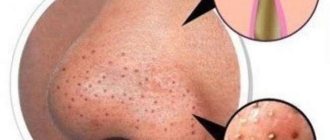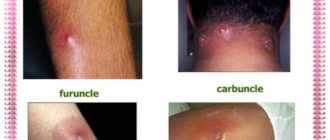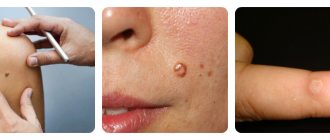Boils can appear on any part of the body where hair grows. A characteristic feature of a boil is that it necessarily goes through several stages in its development. After resolution, a scar almost always remains, but a subcutaneous seal may also form after a boil. If a lump remains under the skin, then the inflammatory process has not ended, and the abscess may manifest itself again.
A boil can appear anywhere on the body
Causes
A furuncle is a pustular disease that affects the hair follicle and the ducts of the sebaceous glands. The reason for the onset of the process is Staphylococcus aureus, which is a permanent inhabitant of the skin, but under the influence of a number of reasons, can become pathogenic. When a microorganism penetrates the upper part of the hair follicle, inflammation begins. Gradually, its focus increases in size and comes to the surface with the formation of a cone-shaped boil.
But infection with a boil can spread both horizontally and vertically and penetrate deep into the dermis. This type of boil does not go away for a long time and is very painful.
If a lump remains after the boil, this is the result of improper treatment.
If a lump remains after the boil, then most likely this is the result of improper treatment. After the abscess resolves and the pus comes out, a necrotic core with a characteristic greenish color remains at the bottom of the ulcer. This lesion will self-reject within a few days, but appropriate treatment should be provided to speed up the healing process. If, due to improper therapy, a purulent core remains, this will lead to the appearance of a compaction after the boil.
Another reason for the pathology lies in the attempt to squeeze out the boil on your own, which is strictly prohibited. Pressing can cause the infection to spread into the deep layers of the dermis and neighboring areas. If the boil has not yet matured, but they try to squeeze it out, what happens is that staphylococci infest neighboring healthy areas and other boils form next to the boil, the number of which can be significant.
If the rod is torn away, but the wound was not treated correctly during healing (many people prefer to treat it themselves), then there is a high risk of infection. And then the inflammation after the boil does not go away, but a new boil forms, which on average will come out again in 3-4 days.
Compaction after a boil can be a consequence of other reasons, primarily diseases that affect metabolic processes.
A lump after a boil may be a sign of scar formation. This is the safest outcome of a boil. Scars are amenable to treatment, which, although it takes a long time, is effective in most cases.
Symptoms and signs of a boil
The formation of a boil involves the development of three stages:
- At the first stage, infiltration occurs around the mouth of the affected follicle. Gradually, the infiltrate (a clot of blood and lymph fluid) increases in size, thickens and becomes painful. The surrounding tissues swell and a tingling sensation occurs.
- At the second stage (after three to four days), the formation of a purulent-necrotic core begins. Gradually its tip extends beyond the surface of the skin. A pustule forms. At this moment, the patient’s body temperature may rise sharply to 38 degrees. Against this background, headache, weakness, mild nausea and dizziness occur. At the peak of inflammation, the lid of the rod is opened and pus pours out. If you forcefully squeeze out the necrotic rod itself, the ailment will quickly go away.
- At the third stage, the crater formed after the opening of the boil begins to tighten. Upon completion, a noticeable scar remains on the skin. At first it is red and blue, then over time it fades and turns pink. If the abscess was small, the scar gradually becomes completely invisible.
When the boil is opened incorrectly, complications arise. The most common phenomenon among them is the appearance of a noticeable thickening under the lingering skin.
Appearance mechanism
After the boil passes, connective tissue begins to fill the remaining wound. Inflammation decreases, swelling subsides. The tissue gradually fills the wound, and if everything is done correctly and infection is prevented, no seal remains. There will be a scar, but it can be corrected with cosmetics, physiotherapy, laser resurfacing, peeling and other means.
There is a possibility of furunculosis
It’s another matter when the surgeon’s excision of the abscess was carried out incorrectly and an infection was introduced. In this case, a large subcutaneous lump may form, which will require long-term treatment with antibiotics and possibly re-opening.
If the boils are not isolated and seals remain after them, then this is a sign of furunculosis. With this disease, multiple ulcers are observed, which may be at different stages of development. And after the boil resolves, others appear in its place or nearby.
Traditional medicine recipes
In the arsenal of traditional medicine there are recipes that can help in the fight against compaction after furunculosis. The most famous of them are the following:
- Treat the bud with lemon juice daily.
- Coat the seal daily with iodine solution at night.
- Compresses with onions (the vegetable is first baked for fifteen minutes in the oven at a temperature of 100 degrees, then after cooling it is cut in half, applied to the lump for forty minutes and fixed with a bandage).
- Compresses with alcohol (we moisten a cotton pad generously, apply it once a day to the seal, fix plastic film and a gauze bandage on top). It is advisable to do the procedure at night.
Practice shows that the most common reason for a lump instead of a boil is an attempt to treat it on your own. Under no circumstances should you squeeze out the abscess yourself; any such skin pathology must be treated under the supervision of a surgeon or dermatologist. If the boil bursts on its own, for example, while bathing in the shower, and there is nothing left to do but help it come out completely, it is important to squeeze out the entire contents (pus, core) until it bleeds. Then treat the wound with any antiseptic. If a lump forms, a visit to the doctor is required.
What measures to take?
After an abscess has resolved on its own or through surgery, it is natural for the area to remain a little sore and red. And if in the first days there is no dynamics in the direction of increased redness and increased pain, then the process of overgrowth and filling of the funnel from the purulent core with connective tissue is underway. The result of this process will be a reddish scar, the color of which will almost match the color of the skin over time.
It is advisable to consult a doctor immediately
If the lump turns into a lump that increases in size and becomes painful, the first thing to do is consult a doctor. This is a sign of infection, which can lead to serious consequences.
Lumps in the face and near the lymph nodes are especially dangerous. Through body fluids, the infection can spread to other organs, leading to inflammation of the lymph nodes, blockage of veins, meningitis and even blood poisoning, which can be fatal.
To combat compactions, which are sunken and protruding scars, various effective means are used today:
- "Mederma";
- "Curiosin";
- "Kontraktubes" and others.
At home, lemon juice and iodine have proven themselves to be effective in correcting scars.
Causes of complications after a boil
The normal development cycle of suppuration is 10 days. Under the influence of internal and external factors, an aggravated course of the disease is possible.
The main causes of complications are:
- irrational treatment of boils;
- presence of concomitant pathology;
- weak immune defense of the body.
Often patients try to squeeze out the contents of the boil, but the boil cannot open on its own, the pus is directed into the tissues, and the infection spreads to other areas. A boil is dangerous in the facial area; therapy without consulting a doctor is prohibited. Self-medication is contraindicated - complications may occur.
Concomitant pathology reduces the body's resistance and its compensatory capabilities. Chronic foci of infection cause secondary immunodeficiencies, which makes a person weakened and allows infection to penetrate. Endocrine diseases contribute to suppurative processes.
Prevention
If you are prone to boils or if this is an isolated case, measures should be taken to ensure that a seal does not appear after a boil. The most important thing is to follow the doctor's instructions. If you did not seek medical help, after the pus is rejected, you need to make applications with Vishnevsky or Ichthyol ointments so that the wound heals faster. In addition, these agents have antibacterial properties, therefore preventing the penetration of pathogenic microorganisms onto the wound surface. At the stage of boil maturation, it is recommended to use local antiseptics. They treat areas adjacent to the abscess to prevent their contamination with staphylococcus and further spread of infection. If everything is done correctly, it will be possible to avoid such a complication as the appearance of a lump at the site of the abscess.
Also, one of the main preventive measures is to strengthen the immune system so that only a strong body can resist the disease.
Why did the lump remain under the skin?
There are several factors that can lead to the appearance of a lump in the place where the painful purulent formation was located. In fact, a lump under the skin may well remain even after an absolutely successful recovery and be natural in such a situation. But it is natural that compaction causes anxiety in a person.
Doctors say that a lump under the skin after a boil may be a consequence of:
- Proper boil removal is not enough. In particular, if, when removing an abscess, the patient did not adhere to the rules of hygiene and did not disinfect the wound, pathogenic microorganisms could penetrate into it and provoke a new inflammatory process. In this case, the lump will cause discomfort (pain), and the skin above it will become hot and red. Sometimes the inflammatory process may develop not directly at the site of the former boil, but next to it.
- Incomplete removal of the rod. If a full-fledged purulent core has managed to form in the source of inflammation, and it has not been completely eliminated, pathogenic bacteria will continue to actively reproduce. Accordingly, a new one will form in place of the old boil. This situation is also accompanied by pain and discomfort.
But most often, compaction at the site of the boil is a natural consequence of such inflammation. The lump occurs due to the growth of connective tissues, gradually healing the wound. In such a situation, the compaction will soon disappear on its own, and only a small scar remains at the site of the purulent process. In some cases, the lump can remain under the skin for a long time and even forever, for example, if a person is prone to the appearance of rough scars or with deep and severe inflammation.
Proper treatment of such a purulent neoplasm will help prevent complications after a boil. Doctors strongly do not recommend getting rid of boils on your own in order to avoid the development of re-inflammation and other dangerous conditions.
What to do if it doesn't work?
Of course, if the appearance of a lump after a boil is accompanied by a number of unpleasant sensations, you should not deal with this phenomenon on your own. After all, bacteria can easily spread through the bloodstream and cause serious complications, including blood poisoning. In such a situation, it is necessary to seek medical help as soon as possible.
If the lump does not cause any discomfort and is an accumulation of connective tissue, you can try to speed up its disappearance with the help of medicines and traditional medicine methods. You can also seek help from a dermatologist or cosmetologist (with medical education). A competent specialist will suggest the most effective methods of dealing with such a problem.
How to remove it with medications?
To help the lump resolve as quickly as possible, you can use special medications:
- Heparin ointment. This medicine contains heparin, which, when applied topically, affects coagulation processes, activates blood circulation, improves metabolism and stimulates healing processes. The drug is applied to previously cleansed skin treated with an antiseptic in a thin layer. It is better to lubricate with it only those areas of the epidermis that are located directly above the seal. The procedure can be repeated up to 3 times. in a day.
- Methyluracil ointment. This has anabolic and anti-catabolic properties, and also has a good anti-inflammatory effect. I recommend using methyluracil ointment to activate regeneration processes in wounds. It should be applied to the affected areas with a thin layer of 2 rubles. in a day.
- Gel with badyaga. This medicine contains an extract of special algae, it has a powerful anti-edematous effect and strengthens blood vessels. When applied topically, it perfectly activates blood circulation, stimulates regeneration processes, and helps resolve hematomas. To remove the subcutaneous seal after a boil, the gel should be applied to the skin in a thin layer shortly before resting at night. You should not repeat the procedure more than once. in a day.
- Retinoic ointment. This medicine contains isotretinoin (retinoid), which is capable of stabilizing the differentiated structures of the epidermis at the cellular level, as well as stopping the proliferation of epithelial structures and activating the regeneration of damaged tissues. Retinoic ointment should be applied directly to the problem area, without rubbing, 2 rubles. in a day. It is worth considering that using the product on exposed skin requires additional sun protection.
- Vishnevsky ointment. This is a complex medicine that has local irritant, antiseptic and reparative properties. To treat a lump under the skin remaining at the site of the boil, the drug should be applied to the problem area in a thin layer and covered with a bandage on top. This procedure should be repeated 2 times. in a day. It should be borne in mind that the medicine stains clothes and has an extremely unpleasant odor.
- Dimexide (dimethyl sulfoxide). This is a budget medicine that is sold in the form of a solution. It perfectly stimulates blood flow, activates tissue nutrition, helps dissolve blood clots and eliminate inflammation. To prepare the solution, you need to combine 3 parts of the drug with 7 parts of water. Soak a napkin or cotton swab in the resulting product and apply to the affected area for 30 minutes. Place polyethylene and a layer of clean cloth on top. Repeat the procedure 1 p. per day.
To choose the most effective remedy for treating lumps under the skin that have arisen at the site of treated boils, you should consult a dermatologist or cosmetologist. Before using any medicine, it is important to carefully study the instructions, especially the list of side effects and contraindications.
Folk remedies
To get rid of unattractive compaction of non-inflammatory origin, you can resort to various methods of traditional medicine:
- Combine 1 tsp. honey with 2 tsp. lemon juice. Apply the mixture to the skin for 30 minutes, then rinse it off with plain water.
- Combine equal parts of rubbing alcohol and water. Soak a cotton swab in the resulting solution and apply it to the affected area for half an hour, carefully securing the compress with a bandage.
- Combine equal parts of apple or table vinegar and plain water. Soak gauze or a cotton swab in the resulting solution and apply it to the swelling like a compress.
- Take 2 tbsp. l. dry sage herb and brew with 1 cup of boiling water. Leave the product covered for 2 hours, then strain. Use to prepare a compress for 30 minutes.
- Peel 1 onion and bake it in the oven (place in a preheated oven for 15 minutes). Cool the vegetable to a pleasant warm temperature, cut in half and apply the cut side to the seal. Fix this design and leave for 40 minutes.
It is worth considering that in the presence of a residual inflammatory process, all of the listed folk remedies are strictly contraindicated. In such a situation, they can do more harm than good.
Other treatments
Sometimes lumps under the skin do not want to disappear even with proper medicinal treatment. In this case, to remove them, the doctor may recommend more radical methods of surgery or cosmetology:
- Removal with a scalpel. The accumulation of connective tissue at the site of the boil can be excised during a classic operation. This method of disposal can be useful in the formation of large lumps that rise above the skin, compress nerve endings, and cause physical and aesthetic discomfort.
- Mesotherapy. This is a cosmetic procedure during which a specialist injects various active substances into the skin. They stimulate regeneration processes and can ensure resorption of the seal. The composition of the mixture for administration is selected individually.
- Dermabrasion or laser resurfacing. With such interventions, the upper layers of the skin are exfoliated, which stimulates regeneration processes. As a result, the bump may disappear or become less noticeable. It is worth noting that such methods of therapy are quite radical and are accompanied by a serious violation of the integrity of the epidermis.
- Physiotherapy methods. Sometimes a lump after injections can successfully resolve after several sessions of UHF (ultra-high frequency therapy) or IR (infrared coagulation).
Of course, the choice of treatment method for the compaction depends on the reasons for its formation, size and location. The doctor also takes into account the individual characteristics of the patient, in particular, the presence of concomitant health problems.
Wound healing
After opening the boil, a wound remains on the body, and if you carefully examine it, a hole from the purulent rod will be visually noticeable in it. Such damage requires close attention and proper treatment. As a rule, this requires:
- Rinse the wound thoroughly with an antiseptic. Usually Chlorhexidine, Miramistin or ordinary hydrogen peroxide are used for this purpose.
- Apply a bandage with antibacterial ointment. Levomekol is most often the drug of choice. It is based on the antibiotic chloramphenicol, as well as a substance with reparative properties, methyluracil. This medicine should be used until the wound is completely healed. As an alternative to Levomekol, doctors can also prescribe Erythromycin ointment.
In the future, the sore remaining on the skin can be lubricated with agents that activate regeneration processes. They prevent the appearance of rough scars and significantly speed up healing. The drugs of choice most often are Solcoseryl, Contractubex, Dermatix, etc.
It is worth considering that the opening of the boil should be carried out by a specialist - a surgeon. Only a doctor can properly treat the wound and prescribe appropriate treatment that will help prevent complications.











